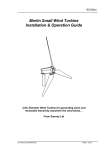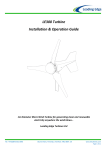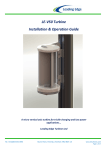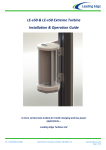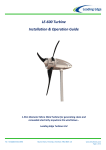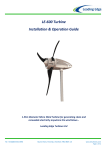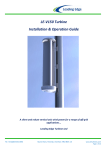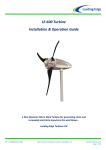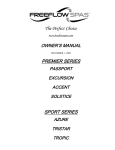Download Chinook 200 Manual
Transcript
Chinook 200 Micro-Turbine Installation & Operation Guide 1m Diameter Micro Wind Turbine for generating clean and renewable electricity anywhere the wind blows… User Manual (Chinook 200) Rev D Final Page 1 Contents Disclaimer...................................................................................................................................3 Introduction.................................................................................................................................4 Safety Precautions.......................................................................................................................5 Specifications..............................................................................................................................6 Package Contents........................................................................................................................7 Assembly.....................................................................................................................................8 Electrical Installation...................................................................................................................13 Turbine Operation........................................................................................................................16 Maintenance.................................................................................................................................17 Replacement Parts........................................................................................................................18 Warranty.......................................................................................................................................19 User Manual (Chinook 200) Rev D Final Page 2 Disclaimer • • • • • • • All specifications are subject to change without prior notice. The information given in this user manual is believed to be accurate and reliable. Chinook Turbines assumes no responsibility for omissions or inaccuracies. The user of this information and product assumes full responsibility and risk. The Chinook 200 Micro-Turbine is a source of electrical power. It must be installed in accordance with local building and electrical regulations. Consult your local planning (zoning) office for details. The Chinook 200 Micro-Turbine has moving parts, and Sharp Blades that may cause injury due to poor installation and unsafe handling or operation. Chinook Turbines assumes no responsibility for problems caused by unsafe or unsatisfactory installation or operation. Made in MONTANA, USA by: Chinook Turbines LLC 1646 East Highwood Rd Belt,MT 59412 www.chinookturbines.com User Manual (Chinook 200) Rev D Final Page 3 Introduction Please read this manual thoroughly before attempting to assemble, install or operate your Chinook 200 small wind turbine. This will assure optimum performance and safety. The Chinook 200 has been designed to be simple, economic, durable and yield excellent performance. Your Chinook 200 turbine features: • • • • • • • Innovative design axial flux alternator using neodymium iron boron magnets. Stamped aluminium chassis. Maintenance-free, low friction bearing. Extremely quiet injection moulded blades with a new airfoil design. Long-life yaw pivot slip-rings and wipers. Easy tower-top installation. Simple design for low cost and durability. The Chinook 200 is most at home in land-based environments Thanks to its unique design, the Chinook 200 is not susceptible to corrosion in normal operating conditions. For Marine installs, Please contact us for a Chinook 200 with Stainless Steel bearing option. Applications include: • • • • • • • • • Remote Homes / Off Grid Wind-electric water pumping Street lighting and road signage Complementary installation with photovoltaic modules for home power Farm utilities (electric fencing, irrigation, etc) Cathodic protection Monitoring sites Telecommunications The Developing World User Manual (Chinook 200) Rev D Final Page 4 SAFETY Safety must always be your primary concern during the assembly, installation and operation of your Chinook 200 turbine. Always be aware of the risks involved with mechanical and electrical installation work. If in doubt about any issue regarding your turbine, please seek further assistance before proceeding. Mechanical Safety Hazards • • • • • • • • The main rotor is the most obvious and serious mechanical safety risk. When the turbine is operating at its rated speed, the blades will be very difficult to see due to the rotation speed. Never approach the turbine while it is operating. Always shut down the turbine by activating the stop switch. Ensure that the turbine is installed in a suitable location where nobody can approach or interfere with the path of the rotor blades. Working with tools of any kind can be dangerous. Your Chinook 200 turbine requires some basic mechanical assembly with rudimentary hand tools. If you are in any doubt about how to use these tools correctly, please seek advice from an experienced person. Your Chinook 200 turbine will inevitably be installed upon a guyed tower or building mount. This may mean working at height. Always ensure that all personnel in the immediate vicinity are aware of any lifting / hoisting operations that will be occurring. Check there are no loose components or tools likely to fall and cause injury during the lifting operation. Where possible, all assembly work should be completed at ground level. Ensure that the batteries are disconnected during the installation procedure. Twist the turbine output wires together (to create a short circuit) during the mechanical installation process. This will prevent the turbine from ‘spinning up’ during the installation. Never install the turbine upside down or in any orientation other than that depicted on the installation instructions. Install your turbine during a calm day. When performing routine inspection or maintenance, always stop the turbine by activating a stop switch or by shorting out the turbine output once disconnected from the battery. Electrical Safety Hazards • • • • • The Chinook 200 generates rectified DC voltage. Even at these low voltages there are inherent risks. Caution should always be used when connecting the Chinook 200 to the electrical system. Ensure that you have followed the wire-sizing chart to ensure that the correct size of wire has been selected. If wire of insufficient size is used, heat will build up in the wires causing a potential fire hazard. A properly sized fuse or circuit breaker should be used in the wires connected to the battery. This will stop the risk of short circuit currents. Batteries used in renewable energy systems can deliver a serious amount of current. A short circuit in the battery circuit can lead to hundreds of amps flowing through the battery cables. This will cause a heat build up and ultimately an electrical fire. Batteries are also susceptible to explode when shorted. Always use insulated electrical tools when working on the battery’s electrical connections. Batteries are very heavy. Do not attempt to move batteries by yourself. Always use manual handling tools and an assistant. Always keep lead-acid batteries the correct way up. Do not allow the acidic electrolyte to spill or come into contact with your skin or face. Always follow the manufacturer’s safety instructions when handling lead-acid batteries. Please use common sense when installing and operating your turbine! User Manual (Chinook 200) Rev D Final Page 5 Specifications Turbine Name: Chinook 200 Part Number: T200 Nominal Voltage: 12 / 24V DC Rotor Blades: Glass Reinforced Nylon Rotor Diameter: 1 Meter (3.28 Feet) Rated Wind Velocity: 8m/s (17.89 mph) Rated Output: 85 Watts Max Output: 300 Watts Rated RPM: 900 Start-up Wind Velocity: 3.5m/s (7.8 mph) Total weight: 6.3 Kg (14 lbs) Tower mount: 1.5” Sch 40 Diameter pipe Chassis Construction: Aluminium User Manual (Chinook 200) Rev D Final Page 6 Package Contents Your Chinook 200 Turbine will arrive containing the components shown below. If any of the components are missing or damaged, please contact your dealer immediately. • 3 Blades • 1 Turbine Chassis • 1 Controller • 1 Spinner (Nose Cone) • 1 Blade mounting plate • Hardware Kit with allen wrenches and Manual User Manual (Chinook 200) Rev D Final Page 7 Mechanical Assembly Procedure 1) Unpacking- Inspect the contents of the box and ensure that all items are present and free from damage. If any of the components are missing or damaged, please contact your dealer immediately. 2) Check Magnet Rotor & Continuity- Ensure that the magnet rotor is free turning and does not scrape or rub on the coil disc as it rotates. You may feel a slight resistance from the bearings at this stage. The bearing units used in the magnet rotor assembly are factory lubricated and sealed for life. It will take approximately 100 hours of normal operation for the bearing seals to ‘Break-in’ and the lubrication to be distributed correctly around the bearing raceways and ball cages. During this period you may notice a reduced performance caused by the additional friction of the bearing seals. In operating temperatures of –10 degrees Centigrade or lower, this ‘Break-in’ period will be extended by a further 50 hours of normal operation. Connect a digital multi-meter to the positive (red) and negative (black) output leads extending from the yaw pivot. With the multi-meter set to detect DC Volts (0-20V), a voltage should be displayed when the magnet rotor is spun. This voltage will vary with the speed of rotation. If the magnet rotor rubs, or no voltage is detected when turning the magnet rotor, please contact your dealer immediately. User Manual (Chinook 200) Rev D Final Page 8 Warning: The magnet rotor on your Chinook 200 turbine is constructed using neodymium iron boron rare earth magnets. These are extremely powerful magnets and can cause injury if not handled with carefully. Take care when working with tools made of ferrous materials (such as wrenches and screwdrivers) close to the magnetic poles. The magnetic forces between ferrous materials and the magnet rotor will be very strong. This may cause a sudden snapping action that can pinch or trap your fingers or skin. Rotor Blade Assembly- Take the three rotor blades and rotor hub plate. Be careful when handling the blades, they may have sharp edges. Use a 10mm socket & hexagon key and three M6 x 16mm long cap-screws to attach each blade to the hub plate. The blades should all be fixed to the hub plate on the same side, with the blades in the same orientation. It is important that a washer is used underneath the Nylock nuts. 3 set-screws, 3 washers and 3 Nylock nuts should be used on each blade. Tighten the Screws until the blades are safely secured. Do not over-tighten the nuts as this may damage the blades and fixings. NOTE: the rotor hub plate has 3- clinch nuts installed for the spinner attachment, the flat side of the clinch nut is the FRONT of the plate. User Manual (Chinook 200) Rev D Final Page 9 Check the Tip Spacing- Lay the assembled rotor blade on a flat surface. Using a tape measure or long steel rule, ensure that the spacing between each tip is equal to within a tolerance of +/-1.5mm. Adjust the blades as required. Output performance may suffer if the blades are not spaced equally. Fit the Rotor Blade Assembly- The assembled and balanced rotor blades can now be fitted to the Chinook 200 chassis. This is done by placing the rotor hub plate against the bearing house on the turbine. In the hardware kit you will find 4 ea 5mm X 12 hex head screws. NOTE, you will have 3 ea 5mm X 14 hex head screws that are LONGER for use on the Nose cone. Ensure that all 4 screws are securely tightened and that the rotor blades are mounted with the flat side of the blades facing forward. User Manual (Chinook 200) Rev D Final Page 10 Check the blade rotation- Once the blades have been fitted and secured to the chassis, ensure that they rotate freely. Also take this opportunity to check that all of the blade and hub mounting screws are secure. Remember that the blades are SHARP! Fit the nose cone- The nose cone can now be fitted to the rotor. This is done by aligning the 3 mounting holes of the nose cone with those on the rotor hub plate. Use the 3ea 5mm x 14 hex head screws to secure the nose cone in position. Ensure that the nose cone runs concentrically (true) by slowly spinning the rotor by hand. Loosening the screws and adjusting the nose cone position should correct any misalignment or ‘wobble’. Make sure you do not over tighten the screws and crack the nose cone (spinner). Prepare the Turbine Mount- To prepare your tower / mount bracket, you will need to drill a 6.5mm diameter hole in order to secure the turbine. This hole should be drilled 18mm from the top of the tower / mount bracket and should be perpendicular to the surface. The hole should penetrate both sides and cross the center line of the tubular section. Install the Transmission Wire- When your tower or mount bracket is ready to have the turbine mounted, the next stage is to run the wire from the top of the tower to where the electrical controller and batteries will be located. Follow the table below to select the correct wire size. This will vary depending on your nominal battery voltage and the distance that the cables will be run. Careful selection of the wire size is required. It will not only affect the safety of the system, but also the overall efficiency. A wire of insufficient size will cause a voltage drop, wasting the power that has been generated. The wire sizes listed below have been selected with efficiency and cost in mind, as it is unlikely that your turbine will be running at full capacity 100% of the time. If in doubt, consult your local electrical supplier. The wire should be installed in accordance with local electrical regulations and guidelines. If in doubt, use a local electrical contractor to complete the wire installation. Warning: If a Wire of insufficient size is used, heat will build up in the wire causing a potential fire hazard. Wire capacities quoted below are based upon AWG wire sizes. Transmission Distance Chinook 200 Output Voltage 12 Volts 30 Feet 90 Feet 300 Feet 8 AWG 6 AWG Not Recommended 24 Volts 12 AWG 8 AWG 4 AWG User Manual (Chinook 200) Rev D Final Page 11 Mount the Chinook 200 Turbine onto the Support Structure- Ensure that the previously installed power transmission wires are not yet connected to any batteries and are ‘shorted’ together. This will prevent the turbine from operating during the installation process. Once this has been done, connect the turbine output wires to the transmission wires using a terminal block with a minimum rating of 30 Amps. Move the turbine up to the support structure and push the turbine body onto the tower. Ensure that no wires are snagged. Use the M6 x 70 fully threaded screw, along with two washers and an Nylock nut to secure the turbine to the tower mount using the hole in the yaw pivot. Ensure that the M6 set-screw is securely fastened. User Manual (Chinook 200) Rev D Final Page 12 Electrical Installation Please refer to the generic wiring diagram (page 15) for a battery charging renewable energy systems, as there may be different ways of wiring small wind turbines, photovoltaic panels, charge controllers and batteries together. This type of system will often expand ‘organically’, but the following guidelines should be adhered to: • Follow the appropriate electrical code - The electrical wiring of your Chinook 200 turbine and associated electrical systems must be done in accordance with national and local electrical codes and regulations. • Do not connect the turbine or batteries during the installation - Ensure that the turbine is not running or connected to the batteries during the installation or wiring process. Connect the output wires of the turbine together to prevent the rotor from starting up. Galvanic corrosion of electrical joints - Try to avoid connections between dissimilar metals. For example, connecting copper and aluminium together will result in galvanic corrosion of the connection. This will increase the electrical resistance of the connection (wasting energy), and reduce the mechanical integrity of the joint. Where possible, use a fluxed solder to make electrical joints. • • Protect the cables - The power transmission wires must be protected from mechanical damage and fatigue. Run the wires through an approved conduit. • Cable strain relief - Prevent mechanical strain on the transmission wires running down the tower from the turbine. Clip the wires to the inside of the tower. Failure to do this will result in excessive mechanical strain on the wire joints within the slip-ring assembly and may cause a failure. Wire ties or cable glands are a good way to prevent mechanical strain on the cables. • ‘Negative Earth’ System - The Chinook 200 turbine is based upon a ‘negative earth’ system. This means that the negative output wire and the turbine chassis is ‘grounded’ at 0 volts. The negative terminal of the battery bank should also be earthed. This provides protection against the build up of static and lightning strikes. The tower should be earthed separately with its own ground rod if there is a long transmission distance between the tower and batteries. An appropriate surge arrestor should also be used to help prevent damage to the battery charging system during a lightening strike. Ensure that the earth cables are of the same rating as the positive and negative cables. • Wire Selection - The wire size table shown on page 11 should be used to select the minimum sized wire for a given transmission distance. Voltage drop in the wire will be improved if a larger wire is used. • Fuses - The turbine and charging circuit should be protected with a suitably rated ‘slow-blow’ DC fuse or DC circuit breaker. Please refer to the table below for the correct rating. The fuse or breaker should be positioned between the turbine and batteries (on the positive wire). If a stop switch is used (recommended) the fuse should be positioned between the switch and the batteries. User Manual (Chinook 200) Rev D Final Page 13 Chinook 200 Nominal Output Voltage 12V DC Fuse / DC Circuit Breaker Rating 24V 13 Amp 25 Amp • Run / Stop Switch - A simple switch arrangement can provide a safe and easy way of stopping the turbine during high winds or for maintenance. A ‘SPDT’ (single pole double throw) switch is best for this purpose. As the switch is thrown, the batteries are disconnected and the turbine is ‘shorted’ reducing the rotor to a slow rotation. Refer to the generic wiring diagram. • Charge Controller - The Chinook 200 diversion charge controller is used to manage the power output from the turbine to the batteries. A diversion charge controller operates by increasingly switching output to a dump load once the batteries begin to reach high voltages. The dump load consumes the ‘excess’ power from the turbine. This means that the turbine’s power output is always utilized whether the batteries are fully charged or not. Depending on the size of the dump load, the turbine may slow down or stall during a period when the power is being diverted. Larger capacity battery banks will be able to store more energy and so the dump load will be used less. • ‘Hybrid’ Systems - The Chinook 200 turbine can be used in parallel with PV panels. We recommend that the PV panels are wired independently with a separate charge controller specifically designed for use with PV panels, and connected in parallel with the battery bank. The Chinook 200 controller can be used with PV Panels as long as the Maximum rated panel output does not exceed 75 Watts when using the turbine’s dump controller. User Manual (Chinook 200) Rev D Final Page 14 3) User Manual (Chinook 200) Rev D Final Page 15 Turbine Operation The Chinook 200 is based on a simple design for ease of installation and reliable operation. You may notice the following behaviour during normal operation: • Cut-in - The turbine will not begin to charge the batteries until the rotor is spinning at approximately 350 RPM. When operating below this speed, the turbine will be ‘Un-Loaded’ and will be freewheeling. Once the turbine output voltage becomes equal to the nominal battery voltage (at around 350 RPM), the turbine will become ‘loaded’ and begin to deliver current to the batteries. During the Un-Loaded stages of rotation, the rotor blades rotate very freely. This allows the rotor to build up speed and allows aerodynamic lift to be generated by the blades. • Normal Operation - Once the rotor is spinning at 350 RPM, current will be delivered to the batteries. As the rotor speed increases, so too, will the current and voltage. Excessive wind speed may increase the battery voltage to a high level. Once this happens, the Chinook 200 diversion charge controller will recognize that the battery voltage is too high, and switch the turbine output to the dump load. • Charge Regulation - Once the charge controller has switched over to the dump load, the turbine will no longer be charging the batteries. Instead, the power from the turbine will be delivered to the dump load (The built in resistive heater element) and the turbine rotor may seem to rotate more slowly. The battery voltage will begin to drop to normal levels during the regulation period. Once the battery voltage is back within acceptable limits, the charge controller will switch the turbine output back to batteries. Refer to the charge controller user manual for specific operational instructions. • Shut Down - By activating the optional stop switch (if you have installed one), the output from the wires of the turbine are ‘shorted’ together. This effectively puts an infinite load on the generator causing the turbine to stall. When the stop switch is activated, the turbine may still rotate slowly during high winds, but the rotor blades will not be able to build up any significant speed. It is not recommended that the stop switch be activated while the rotor is spinning at high speed. This sudden braking action will stress the blades and other components. Activate the stop switch during a ‘lull’ when the rotor is not spinning excessively fast (not following this warning may violate your warranty). • High Winds - Every effort has been taken to ensure that the Chinook 200 will withstand the forces exerted by strong winds. However, the raw power in high winds is immense, and the stresses placed upon the turbine are magnified by gusty and turbulent conditions. Where possible, the turbine should be shut down in advance of particularly strong winds (60+ MPH) and storm conditions. This will decrease the wear and tear on the machine and will help to avoid a failure. The rotor blades may rotate slowly during the shut down period, but the forces exerted will be greatly reduced during strong winds. Protect the turbine from extreme winds as you would protect other items of your property. Note: Never allow the turbine to run Un-Loaded with no connection to a battery bank or dump load. Doing so will allow open circuit voltages to be generated by the turbine. These voltages may be dangerous and will damage the stator coils within the turbine. User Manual (Chinook 200) Rev D Final Page 16 Maintenance Please follow the preventive maintenance program listed below. This will ensure that the turbine operates reliably and safely with good efficiency. Always shut down the turbine before attempting to carry out maintenance. Post-Installation Checks (to be carried out one month after installation): • Check that the tower mount pin is secure and has not worked loose. Adjust if required. • Ensure that the rotor hub is still securely fitted. • Ensure that the rotor blades rotate freely. • Monitor the output. Ensure that the turbine and charge controller are functioning correctly. Annual Maintenance: • Inspect the tower / support structure. • Remove the turbine from its installation to a suitable workbench. • Remove the rotor blade assembly. • Inspect the edges of the rotor blades for damage such as dents or chips. The blades will become unbalanced if they are damaged. This will cause vibration, noise and poor performance. If many dents have occurred along the edges of the blades, a new set of rotor blades should be installed (Contact Chinook Turbines for replacements). • Inspect the roots of the blades (attachment tabs) for signs of stress cracking or fatigue. A new set of rotor blades should be installed if any cracks of fractures have occurred. • Remove any build-up dirt and debris from the rotor blades using mild detergent in warm water. • Check the blade hub for excessive play. • Check and rebalance the rotor blades as required. • Check that all electrical connections are sound and free from corrosion. • Generally ensure that the turbine is in good working condition and is safe for continued use. After Five years of normal operation: • We recommend that the rotor bearing and rotor blades should be replaced after five years of continuous operation. This will ensure that the turbine’s performance and safety is not compromised. Other Considerations: • The equipment used in the charging system (batteries, charge controller, PV panels, etc) should be maintained according to the instructions provided by the equipments manufacturer. • Where lead acid batteries are used, it is especially important that they are maintained carefully. Failure to do so will result in the batteries being rendered useless within a short period of time. User Manual (Chinook 200) Rev D Final Page 17 Replacement Parts The following components may need to be replaced during the service life of your Chinook 200 turbine. Please contact your Dealer or Chinook Turbines for replacements.. Rotor Blades (sold only in sets of 3) Slip Ring Wiper (set of 2) Slip Ring (sold only with yaw mount assembly) Stator (24VDC) Stator (12VDC) Bridge Rectifier Yaw Bearing & Housing Rotor Bearing & Housing Turbine Controller (Is programmed for specific voltage at the factory) User Manual (Chinook 200) Rev D Final Page 18 Warranty Your Chinook 200 Micro-Turbine carries a Three-year warranty from the original purchase date. During the warranty period, any component found to be defective in material or workmanship will, at the discretion of Chinook Turbines, be replaced or repaired at no charge. This may be done on a ‘return to manufacturer’ arrangement for serious defects. For minor component failures, replacements may be sent directly to the customer / dealer for replacement. This can be negotiated at the time of the warranty claim to come to a mutually convenient arrangement for all parties. Chinook Turbines will take all reasonable action to ensure customer satisfaction. Your turbine must be installed and operated in accordance with this guide and local codes. Failure to do so will result in this warranty becoming null and void. Any unauthorized modifications to the turbine design will void the warranty and may compromise the safety of the machine. What is not covered by your Warranty: • • • • • • • • • • • • • • Damage caused by the neglect of periodic maintenance in the manner recommended. Damage caused by repair or maintenance performed using methods not specified by Chinook Turbines or by non-authorized dealers of Chinook Turbines. Damaged caused by the use of non-genuine parts, or from the use of liquid agents or lubricants in or on the turbine, or control equipment. Damage caused by operating the turbine in conditions outside of those specified in the Owners Guide – including, but not limited to, allowing the turbine to run Un-Loaded. Damage caused by modifications to the turbine, tower or control equipment not approved by Chinook Turbines. Damage caused to the turbine, and control equipment by improper storage or transport. Damage caused by lightning strikes. Damage due to extremely high winds and storm conditions (80 mph+). Damage caused by flying debris. Aesthetic phenomena that do not affect performance. Damage caused by unsatisfactory installation of the turbine, and control equipment. Damage caused by unsatisfactory tower / support structure design. Damage caused by incorrect connection to external electrical equipment. Damage from exposure to Marine environment without Marine upgrade. If you should experience a problem with your turbine, your first contact should be the reseller or installer from whom you purchased the product. They will be able to resolve the problem quickly and efficiently. If you are unable to contact the original reseller, then please contact us directly. Please quote the serial number of your turbine when dealing with Warranty issues. The serial number can be found on the nameplate positioned on the underside of the chassis. User Manual (Chinook 200) Rev D Final Page 19




















